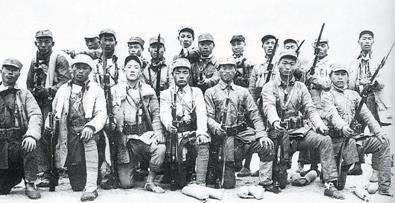History has its own life, it is like a person, both easy-going and self-respecting. ——Yu Qiuyu
Speaking of the Eighth Route Army and the New Fourth Army, we all know that these two units were the anti-Japanese detachments of our Party during the War of Resistance Against Japan. Due to the influence of the Xi'an Incident, the Kuomintang Chiang Kai-shek was forced to agree to stop the civil war, and thus began the second cooperation between the Kuomintang and the Communists. According to the conditions of cooperation, the Red Army of our Party in the base areas of northern Shaanxi was reorganized into the Eighth Route Army, which was later renamed the Eighteenth Group Army, while the guerrillas in the southern region were reorganized into the newly organized Fourth Army, referred to as the New Fourth Army.

New fourth army
Although the Eighth Route Army and the New Fourth Army belong to the same military system, in fact, there is a difference between the two. The operational sequence of the Eighth Route Army was the Eighteenth Group Army of the National Revolutionary Army, which belonged to the group army organization and was one level higher than the army of the newly organized Fourth Army. Therefore, the Eighth Route Army could have three divisions under its jurisdiction, namely the 115th Division, the 120th Division and the 129th Division. The New Fourth Army, on the other hand, had the same department and could only subordinate the detachments.
Eighth route army
So what makes the difference?
At that time, it was also decided that the New Fourth Army would be subordinate to the Eighth Route Army, and it would be organized into two divisions, four brigades, and eight regiments, with the intention of serving as deputy commander, political director Of Chen Yi, and chief of staff of Zhou Zikun. It is equivalent to saying that at first our Party wanted to make the New Fourth Army the battle sequence of the Eighth Route Army, but later, considering the overall situation of the cooperation between the Kuomintang and the Communist Party in resisting Japan, it made some concessions:
Ye Ting proposed to Nanjing; you are not allowed to publish them until they are recognized by the Kuomintang.
But even so, the Kuomintang still refused.
So our party made a slight concession and proposed two columns and six detachments, one of which was Chen Yi and the other was Zhang Dingcheng. However, the Kuomintang still did not agree, and in the end, after consultation between the two parties, our party made concessions, agreeing that the New Fourth Army was not under the Eighth Route Army and was directly under the jurisdiction of the theater; that the army was not under the jurisdiction of divisions, brigades, and columns, but that the army directly administered four detachments, and that only left-behind posts and offices would be set up in various southern regions, and all troops would go to the anti-Japanese front.
Therefore, the final formation of this new Fourth Army was as follows:
(1) The army is organized into four guerrilla detachments in the first, second, third and fourth, and the monthly funding is 15,000 yuan and the military department is 16,000 yuan per month.
(2) Chen Yi, Zhang Dingcheng, Zhang Yunyi, and Gao Jun (Jing) Ting were invited to serve as commanders of the first, second, third, and fourth guerrilla detachments, and they were allowed to follow the committee.
(3) The dispatch fee shall be paid to 30,000 yuan.
(4) The alleged advance borrowing of food expenses shall be handled separately.
(5) The opening and dispatch fee shall be paid to 10,000 yuan, which shall be under the overall control of the military commander.
(6) Five five five-watt radios shall be issued.
(7) The army is under the command of Commander-in-Chief Chen Cheng.
(8) The place of concentration shall be determined by Commander Chen.
In general, when the New Fourth Army was first established, it was still possible, after all, Ye Ting was there, but with the subsequent anhui incident, the New Fourth Army suffered heavy losses, Ye Ting was captured, and Xiang Ying was killed.
Members
So why is the new Fourth Army's organization as an army different from that of the Eighth Route Army? In addition to some differences in numbers, after all, the Eighth Route Army had more than 30,000 people at the beginning, all of whom were veterans of the Long March, and the New Fourth Army was a guerrilla unit in the southern base areas, and it was not superior in terms of combat effectiveness or numbers, and Chiang Kai-shek's obstruction from it, because he did not want the New Fourth Army to merge into the Eighth Route Army, and he was worried that the two teams would be even more difficult to deal with at that time.
However, what Chiang Kai-shek did not expect was that this move of his did not intend to plant willows and willows, so that our party had its own strategic fulcrum in the north and south of the jiangsu river, laying a solid foundation for the establishment of the anti-Japanese base areas behind the enemy lines and the war of liberation. I'm afraid he didn't think of this.